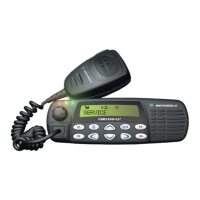2-12
Theory
of
Operation
2.3.4.2 High Speed Data
High speed data refers to the 3600 baud data waveforms, known as inbound signalling words
(ISWs) used in a trunking system for high speed communication between the central controller and
the radio.
To
generate an
ISW,
the
IJP
first programs the ASFIC CMP (U0221)
to
the proper filter and
gain settings.
It then begins strobing U0221-19 (HSIO) with a pulse when the data is supposed to
change states.
U0221
's
5-3-2 state encoder, which
is
in a 2-state mode, is then fed to the post-
limiter summer block and then the splatter filter. From that point, it is routed through the modulation
attenuators and then out
of
the ASFIC
CMP
to
the
RF
board. MPT 1327 and MDC are generated in
much the same way as trunking
ISW.
However, in some cases these signals may also pass through
a data pre-emphasis
block in the ASFIC CMP. Also these signalling schemes are based on sending
a combination
of
1200Hz
and
1800Hz
tones only. Microphone audio is muted during high speed
data
signalling.
2.3.4.3 Dual
Tone
Multiple Frequency (DTMF) Data
DTMF data
is
a dual tone waveform used during phone interconnect operation. It
is
the same type
of
tones which are heard when using a "Touch Tone" telephone.
There are seven frequencies, with four
in
the low group (697, 770, 852, 941Hz) and three
in
the high
group (1209, 1336, 1477Hz).
The high-group tone is generated by the
IJP
(U0101-44) strobing U0221-19 at six times the tone
frequency for tones
less than 1440Hz or twice the frequency for tones greater than 1440Hz. The low
group tone
is
generated by the ASFIC
CMP,
controlled by the
IJP
via SPI bus. Inside U0221 the low-
group and high-group tones are summed (with the amplitude
of
the high group tone being
approximately 2 dB greater than that
of
the low group tone) and then pre-emphasized before being
routed
to
the summer and splatter filter.
The
DTMF waveform then follows the same path as
described for high-speed data
_)

